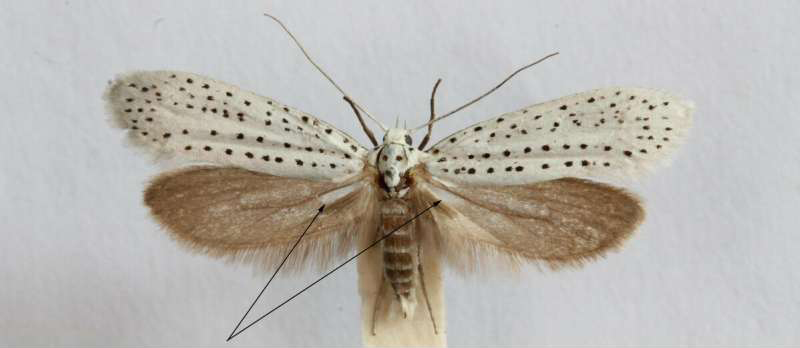Here's Why These Creepy Little Moths Have Noisy, Clicking Wings

A group of deaf moths developed a crunchy, loud tool for warding off bats. As the insects, from the Yponomeuta genus, flutter around, they flex clear, ridged patches on their rear wings. Those ridges bang against the air, perpetually emitting a clicking sound that scares off bats.
"Don't eat me!" the ultrasonic vibration warns. "I'll mess you up!"
This clicking wing patch, said the researchers who discovered it, is part of "a 65-million-year evolutionary arms race" that began way back when bats started using echolocation to hunt moths at night. Scientists already suspected that larger moths used sound to ward off bats. But this is the first evidence that moths like species of Yponomeuta, which are smaller and can't actually hear anything themselves, use sound in the same way. [7 Things You Don't Know About Moths But Should]
It appears that Yponomeuta's clicking communicates to bats that the moths are poisonous, or at least nasty-tasting, said a paper published yesterday (Feb. 5) in the journal Nature Scientific Reports. It's sort of the acoustic equivalent of tree frogs and other daytime critters that wear neon colors to scare off predators.
One other reason moths might make sounds would be startling the bats enough that they fly away. (Imagine you're flapping around, sending out biosonar to find the nearest snack, when a series of high-pitched clicks goes off right in front of you without warning. You'd probably flap away.) But that doesn't make sense, because Yponomeuta emit their clicks at all times, not just when bats get close, the study said.
There's also the possibility that the moths are trying to jam bat sonar, emitting clicks that confuse or distract the predators so they can't find the insects in the air. But Yponomeuta aren't clicking fast enough to do that effectively, the researchers wrote.
Instead, the scientists concluded (after pinning the moths in place to study their flapping and clicking), it appears that Yponomeuta'’s signal is intended to sound like that of larger moths that bats don't like to eat. And the moths make the sound just loud enough that a bat will hear it only when close enough to pick up the moth on its sonar.
Sign up for the Live Science daily newsletter now
Get the world’s most fascinating discoveries delivered straight to your inbox.
It's an elegant strategy. A bat hears Yponomeuta clicking and imagines a different moth entirely, one the mammal generally avoids. And it goes off to eat something else.
This probably isn't just trickery, though: The moths eat lots of plants that contain potential toxins. And researchers already know that birds "force-fed" lots of Yponomeuta tend to get drowsy. So, it's reasonable to suspect there's something in the bugs that bothers bats.
What's probably going on here, the scientists concluded, is that lots of types of moths, including Yponomeuta, have converged on a set of signals that they broadcast as warnings to approaching bats. It's a sort of common moth language that some moths speak (even when they can't hear it themselves) and that bats can hear and understand.
"We're gross!" the moths (more or less) click as they flap around at night. "We're gross, we're gross, we're gross! Don't eat us!"
- Flying Mammals: Gallery of Spooky Bats
- In Photos: Bizarre 'Bat Dinosaur' Discovered in China
- Image Gallery: 25 Amazing Ancient Beasts
Originally published on Live Science.










